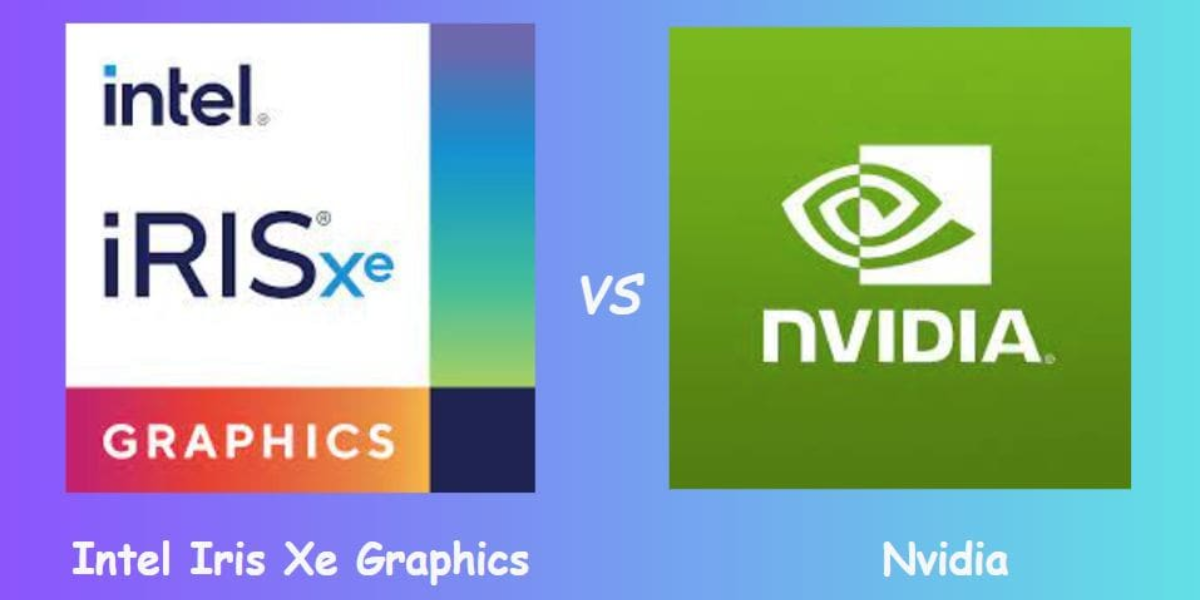In the competitive landscape of integrated and dedicated graphics, Intel’s Iris Xe Graphics G7 with 96 Execution Units (EUs) and NVIDIA’s discrete GPUs stand out as prominent choices for different types of users. This article provides an in-depth comparison of the Intel Iris Xe Graphics G7 96EUs and NVIDIA’s GPUs, focusing on performance, features, and usage scenarios. We will include a detailed stats table to aid in understanding the differences between these two graphics solutions.
What is Intel Iris Xe Graphics G7 96EUs?
The Intel Iris Xe Graphics G7 96EUs is an integrated GPU found in Intel’s Tiger Lake processors. It features 96 execution units (EUs) and is built on Intel’s 10nm SuperFin process. This GPU is designed to offer a significant performance boost over previous integrated graphics solutions, making it suitable for light gaming, multimedia tasks, and productivity applications.
Key Specifications:
- Architecture: Gen12 (Xe)
- Execution Units (EUs): 96
- Base Clock Speed: 400 MHz
- Boost Clock Speed: Up to 1350 MHz
- TDP: 15-28W
- Memory: Shared system memory
- DirectX Version: 12.1
- Manufacturing Process: 10nm SuperFin
Target Audience
Intel Iris Xe Graphics G7 96EUs is primarily aimed at users who require enhanced graphics performance in ultrabooks, laptops, and entry-level desktops. It caters to users who need good performance for everyday tasks, light gaming, and multimedia consumption without relying on dedicated graphics cards.
Overview of NVIDIA GPUs
NVIDIA offers a broad range of discrete GPUs suitable for various use cases, from gaming to professional applications. For comparison, we will focus on a mid-range and high-end NVIDIA GPU to showcase typical performance levels.
NVIDIA GeForce GTX 1660 Super
The GeForce GTX 1660 Super is a popular mid-range graphics card known for delivering excellent performance in 1080p gaming.
- Architecture: Turing (TU116).
- CUDA Cores: 1,408.
- Base Clock: 1,530 MHz.
- Boost Clock: 1,785 MHz.
- Memory: 6 GB GDDR5.
- DirectX Support: DirectX 12.
- Ray Tracing: Not supported.
NVIDIA GeForce RTX 3080
The GeForce RTX 3080 represents NVIDIA’s high-end offerings, designed for 4K gaming and demanding applications.
- Architecture: Ampere (GA102).
- CUDA Cores: 8,704.
- Base Clock: 1,440 MHz.
- Boost Clock: 1,710 MHz.
- Memory: 10 GB GDDR6X.
- DirectX Support: DirectX 12 Ultimate.
- Ray Tracing: Supported.
Also Read: Boom & Bucket Google Reviews: A Comprehensive Guide of Customer Experiences
Intel Iris Xe Graphics vs NVIDIA: Performance Comparison
Intel Iris Xe Graphics vs NVIDIA: Benchmark Comparison
To provide a clear performance comparison, we’ll look at benchmarks from various sources.
| Benchmark | Intel Iris Xe G7 96EUs | NVIDIA GTX 1660 Super | NVIDIA RTX 3080 |
|---|---|---|---|
| 3DMark Time Spy | ~2,000 | ~6,000 | ~18,000 |
| 3DMark Fire Strike | ~3,000 | ~10,000 | ~26,000 |
| GTA V (1080p High) | ~30-40 FPS | ~60-70 FPS | ~100+ FPS |
| Shadow of the Tomb Raider (1080p High) | ~20-30 FPS | ~50-60 FPS | ~90-100 FPS |
| Cyberpunk 2077 (1080p Low) | ~15-25 FPS | ~40-50 FPS | ~70-80 FPS |
Analysis
- Intel Iris Xe Graphics G7 96EUs: As an integrated GPU, it performs well for everyday tasks and light gaming. It falls short in more demanding scenarios compared to dedicated NVIDIA GPUs. The Iris Xe is suitable for users who need decent performance without high-end graphics requirements.
- NVIDIA GTX 1660 Super: Offers a significant performance boost over integrated graphics, making it a solid choice for 1080p gaming. It provides smoother gameplay and better support for higher settings in most games compared to the Iris Xe.
- NVIDIA RTX 3080: Designed for high-end gaming and professional workloads. It excels in both 1080p and higher resolutions, providing excellent performance for the latest games and demanding applications, including those that leverage ray tracing.
Intel Iris Xe Graphics vs NVIDIA: Feature Comparison
Intel Iris Xe Graphics vs NVIDIA: Graphics Features
| Feature | Intel Iris Xe G7 96EUs | NVIDIA GTX 1660 Super | NVIDIA RTX 3080 |
|---|---|---|---|
| DirectX Version | DirectX 12 | DirectX 12 | DirectX 12 Ultimate |
| Ray Tracing | Not Supported | Not Supported | Supported |
| DLSS (Deep Learning Super Sampling) | Not Supported | Not Supported | Supported |
| Tensor Cores | Not Applicable | Not Applicable | Yes |
Analysis
- Intel Iris Xe Graphics G7 96EUs: Lacks advanced features like ray tracing and DLSS, focusing instead on improving standard performance and efficiency in integrated graphics.
- NVIDIA GTX 1660 Super: Provides support for standard DirectX 12 features but does not include advanced technologies such as ray tracing or DLSS.
- NVIDIA RTX 3080: Includes support for the latest graphics technologies, such as ray tracing and DLSS, which enhance visual fidelity and performance in supported games.
Intel Iris Xe Graphics vs NVIDIA: Feature Comparison for Video Editing
Graphics Features
| Feature | Intel Iris Xe G7 96EUs | NVIDIA GTX 1660 Super | NVIDIA RTX 3080 |
|---|---|---|---|
| CUDA Cores | None | 1,408 | 8,704 |
| Ray Tracing | Not Supported | Not Supported | Supported |
| DLSS | Not Supported | Not Supported | Supported |
| OpenCL Support | OpenCL 1.2 | OpenCL 1.2 | OpenCL 2.1 |
| VR Support | Limited | Limited | Advanced |
Analysis
- Intel Iris Xe Graphics G7 96EUs: Lacks dedicated hardware for CUDA or ray tracing, focusing on integrated graphics performance. Limited in handling advanced video editing features that leverage CUDA acceleration.
- NVIDIA GTX 1660 Super: Supports CUDA, which accelerates video editing tasks in software that leverages this technology. However, it lacks ray tracing and DLSS support.
- NVIDIA RTX 3080: Provides comprehensive support for CUDA, ray tracing, and DLSS, making it ideal for high-performance video editing and rendering. Advanced features significantly enhance performance and efficiency in video editing applications.
Intel Iris Xe Graphics vs NVIDIA: Power Consumption and Efficiency
Power Consumption
| Component | Intel Iris Xe G7 96EUs | NVIDIA GTX 1660 Super | NVIDIA RTX 3080 |
|---|---|---|---|
| TDP (Thermal Design Power) | 15-28 Watts | 125 Watts | 320 Watts |
Analysis
- Intel Iris Xe Graphics G7 96EUs: Extremely power-efficient due to its integration within the CPU. This makes it ideal for ultrabooks and laptops where power consumption and battery life are crucial.
- NVIDIA GTX 1660 Super: Higher power consumption compared to integrated graphics but balanced for the performance it delivers. It is suited for mid-range desktops.
- NVIDIA RTX 3080: High power consumption reflecting its high performance. Requires robust cooling solutions and a strong power supply, suitable for high-end gaming PCs and workstations.
Intel Iris Xe Graphics vs NVIDIA: Cost and Value
Cost Comparison
| Component | Intel Iris Xe G7 96EUs | NVIDIA GTX 1660 Super | NVIDIA RTX 3080 |
|---|---|---|---|
| Approximate Price | Included in CPU package | ~$250 USD | ~$700 USD |
Analysis
- Intel Iris Xe Graphics G7 96EUs: Integrated into the CPU package, making it a cost-effective solution for users who do not need high-end graphics performance.
- NVIDIA GTX 1660 Super: Offers good performance for its price, making it a popular choice for gamers on a budget looking for a dedicated GPU.
- NVIDIA RTX 3080: Premium pricing reflects its high-end performance and features. Ideal for users who demand top-tier graphics for gaming or professional work.
Intel Iris Xe Graphics vs NVIDIA: Use Case Scenarios
Intel Iris Xe Graphics G7 96EUs
- Best For: Ultrabooks, lightweight laptops, and everyday computing tasks.
- Limitations: Not suitable for high-end gaming or professional graphics work requiring intensive resources.
NVIDIA GTX 1660 Super
- Best For: Mid-range gaming, casual content creation, and users who want a significant upgrade over integrated graphics without spending too much.
- Limitations: May struggle with very demanding games or tasks at higher resolutions.
NVIDIA RTX 3080
- Best For: High-end gaming, 4K resolution, and professional applications requiring extensive graphical processing power.
- Limitations: High cost and power consumption may not be justified for users with less demanding needs.
Conclusion
The Intel Iris Xe Graphics G7 96EUs, NVIDIA GTX 1660 Super, and NVIDIA RTX 3080 each cater to different segments of the market. The Iris Xe Graphics G7 96EUs excels in power efficiency and integrated performance, making it suitable for everyday tasks and light gaming in laptops. The GTX 1660 Super provides a solid performance boost for gamers seeking value in a dedicated GPU without breaking the bank. The RTX 3080 stands out as a high-end solution for users who demand top-tier performance and advanced features such as ray tracing and DLSS.
Choosing between these options depends on your specific needs, budget, and intended use cases. For integrated graphics with efficient power consumption, the Iris Xe is a great choice. For mid-range gaming and general use, the GTX 1660 Super offers a balance of cost




